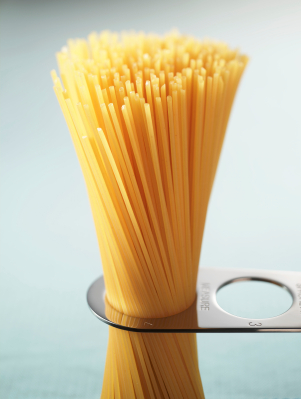By Janis Jibrin, M.S., R.D., TheBestLife.com lead nutritionist
A little calorie denial is OK, but if your denial’s deep, sooner or later you’ll pay the price on the scale. My recommendation: Take a few weeks to measure your food. Once you get portions under control, you’ll automatically cut back on calories. Rolling your eyes already? I know, so many people can’t stand the idea of measuring, but I’m going to make it a little easier by asking you to track just one type of food for a week.
Sure, you could measure and weigh everything that crosses your lips, but most of us aren’t getting fat off of fruit, vegetables, fat-free milk, fish and other healthy, low-calorie foods. It’s bread, potatoes and other starchy foods, as well as fried foods, sugary beverages, sweets, salty snacks, and too much butter, oil, mayo and other fats that get us all into trouble.
This week, I’m going to ask you to focus on one major waistline saboteur: starches. Your goal is to cut way back on white bread, white rice and other refined grain products and enjoy healthy starches like whole grains and sweet potatoes in moderation. (They’re more nutritious and make you feel fuller than refined grains.) For some people, the “in moderation” part can be tricky. That’s why you’ll get so much out of measuring and tracking servings this week; pretty soon you can put away the measuring cups and just eyeball your plate. In just a few weeks, you’ll emerge a portion pro, and you’ll love the results on the scale.
Here’s how it works:
Step 1: Figure out how many daily servings of starches you can get away with. If you’re eating 1,600 to 1,800 daily calories, you get five per day; on 1,800 to 2,100 daily calories, you get six or seven; and if you’re eating more than 2,100 calories per day, you get eight or more servings.
Step 2: Study up on what a serving size looks like using the cheat sheet below (for a visual on some of these, go to Your Portion Cheat Sheet).
A serving is 80 calories and looks like:
- Bagel – ¼ big or ½ small
- Bread – 1 slice
- Cold cereal – amount varies; check label to see how much you get for 80 calories. For cereal suggestions and portion sizes, click here.
- Corn – ¾ cup frozen, canned or cooked from raw kernels
- Corn meal/polenta – 1/3 cup cooked (stone ground whole)
- English muffin – ½ muffin (100 percent whole grain)
- Hot cereal – ¼ cup dry or ½ cup cooked
- Legumes, including black beans, chickpeas (garbanzo beans), kidney beans, white beans, lentils, etc. – 1/3 cup cooked or canned
- Pasta – ½ cup cooked
- Steel cut oats – 1/8 cup dry or 3/8 cup cooked
- Sweet potatoes, potatoes or peas – ½ cup cooked
- Whole grains, including barley, bulgur wheat (cracked wheat), couscous, rice, wheat berries – ½ cup cooked
Note: All grains should be whole grains.
Step 3: Start eating!
Comment below to let us know how it went this week—any surprises?
Also Read:
17 Healthy Carbohydrates You Should be Eating
